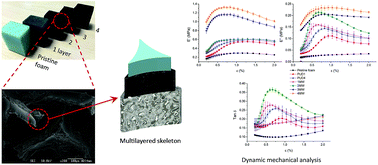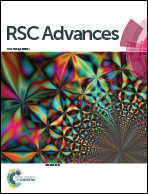Carbon nano-ink coated open cell polyurethane foam with micro-architectured multilayer skeleton for damping applications†
Abstract
This work presents a mechanism to generate energy dissipation by creating novel multilayer microstructure architectures via nano-inks and improving the mechanical, damping and dielectric performance of open cell foams. A multilayer carbon nano-ink containing –COOH functionalised multi-walled carbon nanotubes is produced and used to dip-coat pristine polyurethane open cell foam structures with the assistance of a silane coupling agent. Another layer of water-based polyurethane dispersion is coated on top of the MWCNT layer coated foam to transform the single foam ribs in multilayer structures. The nano-ink dipping and drying process developed in this work creates a porous MWCNT layer with a fairly high MWNT content that covers the foam ribs. These carbon nanotube multi-layer coated foams show a significant damping performance with loss modulus and loss factors 165% and 100% higher than those from high-dissipation nano-foams fabricated by conventional foaming techniques and auxetic phase transformation respectively. These nano-ink multilayer coated foams with only one layer also exhibit an increase in electrical conductivity by a factor of 2 compared to other existing nano-ink coated open cell foams with a substantially higher number of layers (20).


 Please wait while we load your content...
Please wait while we load your content...